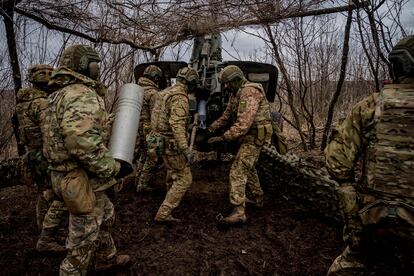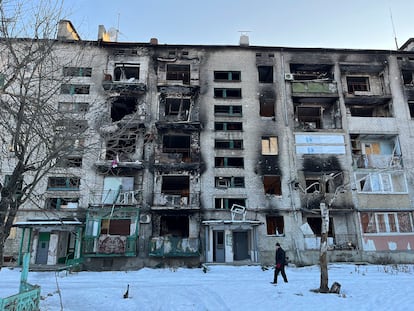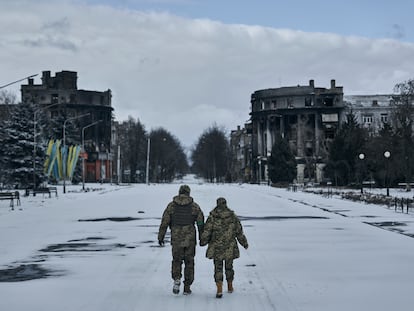Inside Bakhmut, Ukraine’s ‘fortress city’ standing in the way of Putin’s advance in Donbas
Moscow has been intensifying attacks to encircle Kyiv’s troops as Volodymyr Zelenskiy considers retreat to a new defensive line. Drone units have become vital for detecting Russian artillery and infantry movements

“Quick, quick, this way!” Sergeant Yaroslav slams the muddy four-by-four into full throttle and heads down the smoking highway to Bakhmut. The road, pockmarked with craters and fresh artillery scars, is the last umbilical cord linking the highly symbolic city in the Donetsk region with the territory under the control of Ukrainian forces. It is under constant attack by Russian troops, who are attempting to surround the city and cut off its only means of supply. Bakhmut has been under siege for weeks and is the scene of the bloodiest fighting of the war in Ukraine, where swarms of surveillance drones fill the sky above street-to-street combat. Much of the city is in ruins.
By day it is a ghostly landscape and the aerial reconnaissance unit, christened OCHI (Eyes) and commanded by Sergeant Yaroslav, strategically operates its drones in search of Russian targets. Ukrainian forces take shelter inside gutted buildings to avoid being targeted by the enemy. Bakhmut is a closed city. Civilians are no longer permitted to enter, and neither can convoys get through to evacuate those that remain behind. Of the 70,000 inhabitants of Bakhmut before the invasion, fewer than 4,000 remain and they rarely leave their basements, which have been converted into makeshift shelters. When darkness falls, Russian infantry and Wagner Group mercenary commandos come in waves. “Then this place is simply hell,” says Sergeant Yaroslav, grimacing and stroking his dark beard.
It is an inferno that is exacting a heavy toll on Russian forces, who are send to die in droves, but also on the Ukrainian defenders. Bakhmut, which has little military value but has assumed great political significance, has been holding out for months. But, inch by inch, the Kremlin has been making grueling progress, taking small villages, farms, and fields. Russian forces now control several parts of the city and three of the flanks surrounding it. Vladimir Putin, who before the invasion was considered a solid military strategist with one of the most powerful armies in the world at his disposal, has suffered a series of battlefield reverses and is seeking to secure a first combat victory in months by capturing Bakhmut.
With the arrival of spring and as the war enters its second year, Ukrainian President Volodymyr Zelenskiy has changed his stance on Bakhmut. Weeks ago, he stated that the “fortress city” would hold out until the end. Now, he has acknowledged that Kyiv will not seek to continue the defense of Bakhmut at any price. “The situation is becoming more and more difficult,” Zelenskiy said this week. Ukrainian troops could be withdrawn to fortified positions on higher ground, a few kilometers outsides the city, where defensive lines have already been prepared. That would open the door for the Kremlin to close its jaws around a mouthful of terrain, but in return, Kyiv would succeed in straightening the line on the eastern front.
Kyiv has committed a large number of units to the defense of Bakhmut and the surrounding area. Inside the city, Ukrainian troops are exhausted and empty-eyed. The Russian assault is relentless and reinforcements have been arriving in recent days, according to Ukrainian Deputy Minister of Defense Hanna Maliar. However, it remains unclear whether these reinforcements are being deployed to try to maintain control of the city or to provide cover and logistical support in the case of a retreat - and to prevent Bakhmut from becoming a new Mariupol, the strategic city on the Sea of Azov besieged for three months at the outset of the war and where the last remaining defenders were eventually forced to surrender and taken prisoner.
Kyiv is planning a counteroffensive on the eastern and southern flanks, where the objective is to sever the corridor Russia has created by occupying territory between the Crimean Peninsula (illegally annexed by Moscow in 2014) and the Donbas region. But to do so, in addition to the expected new shipments of Western armaments and precious ammunition, the Ukrainian military needs boots on the ground. And to ensure that, Kyiv may have to drop the defense of Bakhmut.
Downtown Bakhmut has been largely razed to the ground. Mrs. Svetlana’s little store on one of the tree-lined, elegant avenues is no more. A man with a blank expression and a raffia bag walks along one of the main thoroughfares, littered with ditches, trenches, rusting iron and skeins of wires. Power lines are down all over the city, where there has been no supply of water, electricity, or gas for months. “I’m not leaving, I’m not leaving. I’m staying,” the man shouts as he continues on his way, oblivious to the shaking of the ground and the permanent thud of artillery fire. It is not safe to walk through the deserted streets, where the feeling of being watched is ever-present.
Sometimes those eyes belong to Sergeant Yaroslav’s OCHI unit, which occupies several positions in Bakhmut and outside the city, from where they help hold the front line and prevent Russia from tightening the crescent of territory it controls. Yaroslav’s section works fast. They arrive at one of their bases, just a mile from the Russian positions, deploy their material and their drone - a civilian DJI Matrice - connect the backup batteries, activate an Internet connection through the Starlink satellite network and start sweeping the area for Russian troops.
In a damp basement just outside Bakhmut, Sergeant Yaroslav watches a screen feeding back images of the city and its surroundings while his partner Oleksii operates the drone controls. Kir, the third member of the group, reviews the coordinates that will be sent to an artillery brigade. There is a trench, a bombed-out hut, an empty Russian base. In the sweep of the drone lens, which has a radius of six miles, Bakhmut is blanketed in gray from the smoke of several explosions. They search, relay their information, and change position when necessary. They work from dawn to dusk, synchronized, in tune, a well-oiled machine.
Yaroslav, Oleksii and Kir have been together for a year. They enlisted on the morning of February 24, 2022. Kir, a sharp-eyed 32-year-old, received a call from his twin brother in the port city of Mykolaiv in the early hours of the morning. “I was in Kyiv and he said: ‘Open the window, the war has started,’” he recalls. His brother and mother are also in the army, in the medical corps. Kir had already fought in the Donbas conflict, which began in 2014 when pro-Russian separatists attacked in eastern Ukraine, then he became a yacht skipper and had been travelling in warm climates carrying tourists. On his cell phone, he pulls up a video of the boat on a golden, sandy beach. “Now I look forward to what used to be just another day, a normal day in my civilian life,” he says.

Yaroslav, 34, ran a small construction company before the invasion. In January, he became a father for the third time, a baby girl. He has never met her, he says: his family left months ago for Slovakia. “I’ve only seen her in pictures or video calls.” With three children, Ukrainian martial law permits him to leave the country and join his family, but he prefers to wait. “I’m staying: the more of us there are and the more effective we are, the sooner this will end.” They only give their first names or an alias. This is the general rule in the Ukrainian military, but Yaroslav says Russian forces are trying harder to identify, locate and hunt down drone pilots.
Yaroslav’s OCHI unit has been in Donbas for the last four months. In the battle for Bakhmut, an artillery and infantry engagement, drones are becoming increasingly valuable in complete contrast to the character of the rest of the fighting, which is closer to the conditions experienced in World War I than a 21st century conflict, according to analysts. In the absence of military drones, which are becoming increasingly scarce, the Ukrainian army is using commercial devices to provide visibility on the ground, which allows for greater precision in artillery fire.
On the shell-scarred, desolate terrain outside the small OCHI base, Oleksii scans a clear sky and takes aim with his rifle. His drone is on the ground and the eerie sound of other unmanned aircraft can be heard. “That one is Russian,” he says. The Kremlin also deploys large numbers of these devices, and they are of good quality. Not only the Iranian-made Shahed attack drones, used in massive air strikes against civilian infrastructure, but also Orlan reconnaissance aircraft. “They also have eyes, but although we have room for improvement, we are more effective. This is our land; we are also guided by our hearts. And sometimes that is worth three times as much,” says Sergeant Yaroslav.
Sign up for our weekly newsletter to get more English-language news coverage from EL PAÍS USA Edition
Tu suscripción se está usando en otro dispositivo
¿Quieres añadir otro usuario a tu suscripción?
Si continúas leyendo en este dispositivo, no se podrá leer en el otro.
FlechaTu suscripción se está usando en otro dispositivo y solo puedes acceder a EL PAÍS desde un dispositivo a la vez.
Si quieres compartir tu cuenta, cambia tu suscripción a la modalidad Premium, así podrás añadir otro usuario. Cada uno accederá con su propia cuenta de email, lo que os permitirá personalizar vuestra experiencia en EL PAÍS.
¿Tienes una suscripción de empresa? Accede aquí para contratar más cuentas.
En el caso de no saber quién está usando tu cuenta, te recomendamos cambiar tu contraseña aquí.
Si decides continuar compartiendo tu cuenta, este mensaje se mostrará en tu dispositivo y en el de la otra persona que está usando tu cuenta de forma indefinida, afectando a tu experiencia de lectura. Puedes consultar aquí los términos y condiciones de la suscripción digital.
More information
Archived In
Últimas noticias
There is as much life left to discover on planet Earth as that which is already known
Dozens presumed dead, around 100 injured in fire at Swiss Alps bar during New Year’s celebration
Is porn for women different from conventional porn? We spoke to those who make it
Cartagena de Indias is sinking: What can the city do to mitigate it?
Most viewed
- Sinaloa Cartel war is taking its toll on Los Chapitos
- Reinhard Genzel, Nobel laureate in physics: ‘One-minute videos will never give you the truth’
- Oona Chaplin: ‘I told James Cameron that I was living in a treehouse and starting a permaculture project with a friend’
- David King, chemist: ‘There are scientists studying how to cool the planet; nobody should stop these experiments from happening’
- Why the price of coffee has skyrocketed: from Brazilian plantations to specialty coffee houses











































